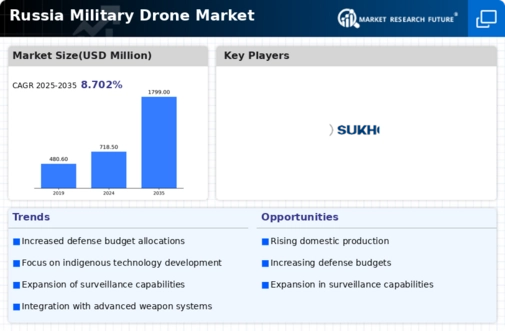Geopolitical Tensions
Geopolitical tensions in Eastern Europe and surrounding regions significantly influence the military drone market in Russia. The ongoing conflicts and the need for enhanced surveillance capabilities drive the demand for military drones. As tensions escalate, the Russian military is likely to invest more in unmanned aerial vehicles (UAVs) to maintain situational awareness and operational superiority. Reports indicate that the military drone market could see a growth rate of around 15% annually as a direct response to these geopolitical challenges. This environment necessitates the development of advanced drone systems capable of performing reconnaissance and strike missions, further solidifying the market's importance in national defense strategies.
Strategic Military Modernization
The ongoing strategic military modernization in Russia appears to be a primary driver for the military drone market. The Russian government has prioritized the enhancement of its military capabilities, which includes the integration of advanced drone technology. This modernization effort is reflected in the 2025 defense budget, which allocates approximately 20% more funding towards unmanned systems compared to previous years. The military drone market is likely to benefit from this increased focus, as the demand for sophisticated surveillance and combat drones rises. Furthermore, the emphasis on developing indigenous drone technologies may lead to a reduction in reliance on foreign suppliers, thereby fostering a more robust domestic military drone market.
Increased Focus on Autonomous Systems
The military drone market in Russia is experiencing a notable shift towards autonomous systems. The Russian military is increasingly interested in developing drones that can operate with minimal human intervention, which could enhance operational efficiency and reduce risks to personnel. This trend aligns with global advancements in artificial intelligence and machine learning, which are being integrated into military applications. The market for autonomous drones is projected to grow by approximately 25% over the next five years, driven by the need for more sophisticated and capable unmanned systems. This focus on autonomy may lead to innovations in drone design and functionality, positioning Russia as a competitive player in the military drone market.
Investment in Research and Development
Investment in research and development (R&D) is a crucial driver for the military drone market in Russia. The government has recognized the importance of innovation in maintaining a competitive edge in defense technology. In recent years, R&D funding for military applications has increased significantly, with estimates suggesting a rise of 30% in allocations for drone technology. This investment is likely to foster advancements in drone capabilities, including improved payload capacity, endurance, and stealth features. As a result, the military drone market is expected to expand, with new products emerging that meet the evolving needs of the Russian military. The emphasis on R&D may also encourage collaboration between defense contractors and academic institutions, further enhancing technological advancements.
Growing Demand for Surveillance Capabilities
The growing demand for enhanced surveillance capabilities is a key driver of the military drone market in Russia. As military operations become more complex, the need for real-time intelligence and reconnaissance has intensified. Drones equipped with advanced sensors and imaging technologies are increasingly viewed as essential tools for modern warfare. The military drone market is projected to grow by approximately 18% annually, driven by this demand for surveillance solutions. The Russian military is likely to invest in drones that can provide comprehensive situational awareness, enabling more informed decision-making during operations. This trend underscores the critical role that military drones play in contemporary defense strategies, particularly in the context of evolving security challenges.












Leave a Comment